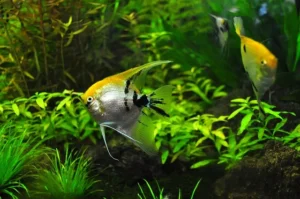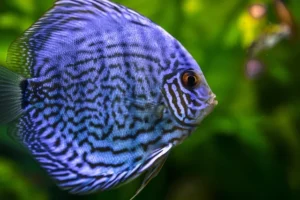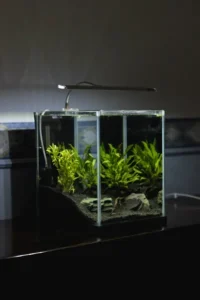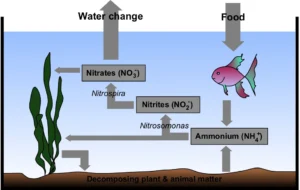A fish tank is great addition to any home (or office) and provides a glimpse into another world. A world of wonder, fascination and beauty.
And there’s nothing more relaxing than gazing at beautiful fish tank, plants swaying with fish swimming among them and darting in and out hiding places in among the rocks and caves.
A fish tank is the perfect antidote to modern stressful living.

So, if you want to know how to start a freshwater fish tank you’ve some to the right place.
If you’ve decided to take the plunge and begin creating your own water world there are a number of things you should consider first.
First and foremost, fish should be treated just like any other pet. You’ll need to care for and feed them and provide them with a safe and stimulating environment. And because that environment is under water means we have additional responsibilities.
In the ocean and in lakes, ponds and rivers water is kept clean and filtered naturally in a process developed over millions of years. In the closed environment of a fish tank we need to help.
That means providing the correct heating, lighting and filtration, feeding appropriately and conducting regular water changes and equipment maintenance.
So the first thing to decide is what type of fish do you want to keep. This is important as some fish have very different requirements and some are not compatible with others.
Sadly many new fish keepers ignore this step or don’t do enough research.
Table of Contents
- Research Your Fish
- Choosing the Right Fish Tank Size
- Placing your Fish Tank
- Choosing the Type of Fish Tank
- Choosing the Type of Substrate for Your Fish Tank
- Decorating Your Fish Tank
- Filling Up Your Fish Tank for the First time
- Cycling Your Fish Tank
- Adding Your First Fish
- Maintaining Your Fish Tank
- Freshwater Fish Tank FAQs
Research Your Fish

It’s important to do your research while deciding what type of fish you wish to keep. A cold water fish, like goldfish, for example can not be kept with tropical fish like neon tetras.
Certain Barbs, like Tiger Barbs are aggressive to other fish and are best kept in a single species tank. Plecos and some catfish can get very large and soon outgrow a small aquarium.
Some fish like Discuss must be kept in a larger tank with very regular water changes. Other fish have special dietary requirements which can get expensive.
So do your research, there’s a wealth of information online. You could also check out our Best Freshwater Community Tank Fish guide which has some great fish for beginners.
Maybe you wish to start a cold water aquarium? In that case check out our article on the Best Cold Water Aquarium Fish to choose.
Choosing the Right Fish Tank Size
The size of the fish tank you need should primarily be driven by the requirements of the fish you wish to keep but there are of course other considerations such as cost and available space for placing the tank and cabinet. Also, don’t forget a fish tank full of water is heavy…very heavy.
And it’s not just the water as you’ll be adding sand or gravel for substrate and rocks or wood for decoration.
A 90cm (or 3 feet ) wide aquarium holding around 200 litres of water will weigh approximately 220 – 250 kilograms when filled depending on how many rocks, etc. you also add.
In addition, there’s also the weight of the cabinet or stand to consider.
So make sure the location you intend to put your fish tank can support the weight. You’ll need to take particular care if you either live or intend to put the tank on any floor above the ground floor.
Remember also that a larger tank will cost more to run as it will have a greater power consumption than a smaller tank.

Placing your Fish Tank
Care should also be taken when deciding where you place your fish tank. It’s best to avoid placing the tank near a window that gets direct sunlight. If direct sunlight hits your tank it can possibly overheat the water and also lead to algae growth problems later on.
Likewise avoid placing the tank near any heaters, radiators or fires as they may effect the temperature in your tank. Similarly, noise or vibration will startle and stress your fish.
And you obviously need to be close to an electrical outlet.
It’s important to get the placing right before you add any water as a fish tank should never be moved once filled or partially filled with water.
Your tank must also be on a flat level surface. If a full tank is not level it can cause undue stress on the seams and they could eventually split and burst causing a catastrophe.
Use a spirit level to check this, placing it on the top of the glass at the front, sides and diagonally across the corners. You can use shims under the tank cabinet to get it level or adjust the feet on the tank if they are adjustable.
Choosing the Type of Fish Tank
Most people when starting out in fish keeping will choose a starter all-in-one fish tank. That’s to say the tank comes with the necessary lighting, aquarium heating and filter equipment.
Many come with a tailor made cabinet to stand the tank on so you’ll know it can bear the weight and they usually have handy storage areas for equipment, etc.
Smaller tanks usually come with an internal filter which sits inside the tank whilst some larger ones have an external filter where water is circulated between the tank and filter by plumbing under the tank.
Whichever you choose be sure to fully read the assembly and set-up instructions before you start.
For more information, check out our guide to the Best Freshwater Fish Tanks.
Choosing the Type of Substrate for Your Fish Tank
There is a wide variety of substrate that you can choose from to line the bottom of the tank and what you choose largely depends on how you want the tank to look.
A natural sandy or gravel bottom or multicoloured or even black, the choice is endless.
You can also get substrate designed to help live plants grow with these typically being rich in iron and other minerals.
Whichever you choose be sure to rinse it thoroughly before adding it to your tank or it will be cloudy for days!
Decorating Your Fish Tank
Whatever fish you decide on, they will all benefit from having places to hide so they can feel more secure. To that end, you’ll want to add some rocks or driftwood and some plants (real or artificial).

Filling Up Your Fish Tank for the First time
Ok so you’ve got your tank set-up, the heater and filter are installed (but NOT turned on). The substrate has been laid and any rocks and decorations have been added. You’re now ready to add water.
As it’s your first time there’s no need to pre-heat the water but it will need dechlorinating first if you’re using tap water. You can do this in a bucket before you add it to the tank or afterwards when the tank is full.
All tap water contains chlorine and chloromides to make it safe for us to drink but these can kill your fish so the water needs dechlorinating.
This is simply a matter of buying a dechlorinating liquid and adding the right amount to the water. There are many available and you can get them at your local fish store or online. Just follow the instructions.
Alternatively, you might want to consider using RODI water for your tank. Our article, Using RO Water In Your Aquarium explains why you should consider it.
When adding the water it’s best to place an upturned small plate or saucer on your substrate and then pour the water onto that to avoid disturbing the substrate too much. Use a one litre jug and do it slowly.
Once the water is at a depth of about 10cm pause to check again that the tank is level. Measure around all sides from the bottom of the tank to the water surface.
Do this again when the tank is half full. Again, you can use shims under the tank cabinet to get it level or adjust the feet on the tank if they are adjustable.
When the tank is half full it’s a good time to plant any live plants. Push them down gently into the substrate and press substrate around them so they don’t float away.
Once the tank is fully filled you can now turn on the aquarium heater and filter and slowly the water temperature will rise to that set on your heater.
Most tropical fish require the temperature to be between 75-80 degrees Fahrenheit (23-27 degrees Celsius)
You’ll need to choose the right heater for your aquarium, so take a look at our guide, Best Rated Aquarium Heaters for assistance.
We also recommend using a temperature controller to control your heater.
There is no need yet to turn on the lights but you are bound to do so, to see how it looks. Just remember that excessive lighting can lead to algae problems later on.
Also remember that your fish need to sleep as well. As a general rule fish tank lights should only be on for 8 – 12 hours per day.
It’s best to get a plug timer for your lights to control this and make it a regular pattern of night and day for your fish.
Great! All done and you can now add fish! Except… You should NOT do so at this point.
Why?… because your tank is not yet biologically cycled.
Not cycling your fish tank properly is the biggest cause of fish deaths for new fish keepers
Cycling Your Fish Tank

Filtration in your fish tank is in three stages.
Mechanical filtration is handled by your filter and this traps solid debris like fish waste, uneaten food and plant debris. Your filter will have sponges or floss to do this job.
Chemical filtration uses media (usually activated carbon) which traps pollutants that may cause your water to smell or be discoloured. Again this can be added to your filter if it is large enough.
The third stage is the most important one and this is Biological filtration whereby good bacteria in your tank converts the toxic ammonia in your tank (caused by fish waste) first into nitrites and then nitrates which are not toxic to your fish (unless in very high quantities) and also help feed any live plants you may have.
This good bacteria will grow naturally in your tank in a process called the Nitogen Cycle.
The good bacteria will reside both in your filter and on rock, wood and plant surfaces but it takes time to develop…
It usually takes around 6 -8 week for a tank to be fully biologically cycled and fish should NOT be added until it is.
I go into much more detail here on how to cycle your fish tank and how you can shorten the process by using bacteria supplements.
Remember – If you do not fully cycle your tank your fish may die.
Adding Your First Fish
Ok so now your tank is cycled and you can finally add your fish!
But again you should proceed slowly only adding a few fish at a time.
Let’s assume, for example, that you are going to add small fish, possibly different types of tetra, to a 60 litre tank.
As a general rule you should only be adding 1 cm of fish per litre of water. So in a small 60 litre tank you can add 60 cm of fish. A typical tetra may reach 3 cm in length so you can add 20 in total.
In this example though, you should only add around 5 fish per week over approximately four weeks. This will allow the good bacteria in your tank time to grow and adapt to the increase in fish waste as you add more fish.
As you add your fish remember to acclimatise them first.
This means floating them in the bag they came in in your tank so that the water temperature in the bag reaches the same temperature as your tank water.
You can also add small quantities of your tank water to the bag to help the acclimatisation process further. This should take around 30 – 40 minutes.
Once acclimatised simply tip the fish and water slowly from the bag into your tank.
You should also turn off your lighting for 2 – 3 hours during acclimatisation and after the fish have been added.
You may find they may hide at first but once settled in they will soon be out and about for you to enjoy.
Only feed sparingly twice a day and only enough that they can eat it all in 4 – 5 minutes.
Wondering what to feed your new fish? Check out our article, Best Tropical Fish Food for information and advice.
With new fish, keep a careful eye on them for signs of disease during the first few days. Unfortunately, diseases like Ich are easily introduced but they can be treated.
Read our guides on Treating Ich In Your Aquarium and Common Tropical Fish Diseases and Treatments to find out more.

Maintaining Your Fish Tank
Keeping your fish tank maintained means cleaner water and a better, healthier environment for your fish.
Water Changes
Principally this means doing a regular 10 – 25 % water change every one or two weeks and cleaning your filter at a similar interval.
Simply take the required amount out by syphoning it into a bucket and replace it with dechlorinated water at the same temperature as your tank.
Add hot water to your replacement water until the temperature matches. You’ll need a small thermometer to check this.
A water change will stop nitrates getting too high in your tank and also replace valuable minerals.
Filter Maintenance
To clean your filter simply remove any sponges and rinse them out in the used water you have taken out when doing a water change.
Do NOT rinse them under the tap as this will kill the good bacteria that lives in your filter sponges.
Please remember to unplug all electrical equipment when doing any maintenance on your tank.
Testing
You’ll need to test for nitrate and other parameters regularly. We provide more information on what to test for in this article, How to Test Your Freshwater Fish Tank.
We hope you’ve enjoyed this article on how to start a freshwater fish tank. Please have a look around our site for more advice and information.
Or are you considering a saltwater tank? If so, check out our article, How to Start a Saltwater Fish Tank.
Freshwater Fish Tank FAQs
Can I use tap water for my fish tank? – Yes, you can use tap water but you must add a dechlorinating agent first. Tap water contains chlorine and chloromides to make it safe for us to drink but these can kill your fish.
Can you put fish in a new tank the same day? – No, it is not recommended. Your tank needs to be fully biologically cycled first. Fish waste, etc produces ammonia which is deadly to fish.
The biological ‘Nitrogen’ cycle processes ammonia, first into Nitrites and then Nitrates. Excess nitrates and then removed by water changes.
What is the fastest way to cycle a freshwater tank? – The fastest way to cycle a tank is by using a good bacteria supplement. Using one shortens the process from 6 – 8 weeks to 1 or 2 weeks or even days.
How often should you change the water in a fish tank? – Depending upon the size of the tank and how many fish you have, you should perform a 10 – 25 % water change every one or two weeks.
Do you leave fish in the tank when changing water? – Yes, you should always leave the fish in the tank. It would be far more stressful for them to be removed. Syphon out the water from the top of the tank taking care that you don’t accidently suck up any small fish.
